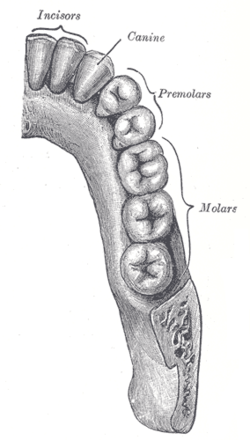Premolar teeth
| Premolar | |
|---|---|

The permanent teeth, viewed from the right.
|
|

Permanent teeth of right half of lower dental arch, seen from above.
|
|
| Details | |
| Identifiers | |
| Latin | dentes premolares |
| MeSH | A14.549.167.860.150 |
| TA | A05.1.03.006 |
| FMA | 55637 |
|
Anatomical terminology
[]
|
|
The premolar teeth, or bicuspids, are transitional teeth located between the canine and molar teeth. In humans, there are two premolars per quadrant in the permanent set of teeth, making eight premolars total in the mouth. They have at least two cusps. Premolars can be considered as 'transitional teeth' during chewing, or mastication. They have properties of both the anterior canines and posterior molars, and so food can be transferred from the canines to the premolars and finally to the molars for grinding, instead of directly from the canines to the molars.
The premolars in humans are the maxillary first premolar, maxillary second premolar, mandibular first premolar, and the mandibular second premolar.
There is always one large buccal cusp, especially so in the mandibular first premolar. The lower second premolar almost always presents with two lingual cusps.
Molar teeth by definition are permanent teeth distal to the canines, preceded by deciduous premolars. In primitive placental mammals there are four premolars per quadrant, but the most mesial two (closer to the front of the mount) have been lost in catarrhines (Old World monkeys and apes, including humans). Paleontologists therefore refer to human premolars as Pm3 and Pm4.
...
Wikipedia
